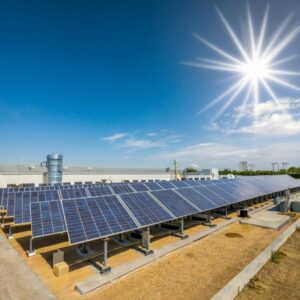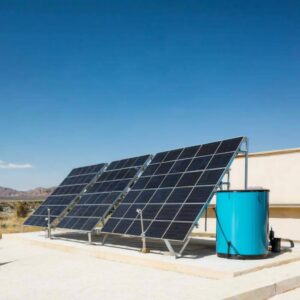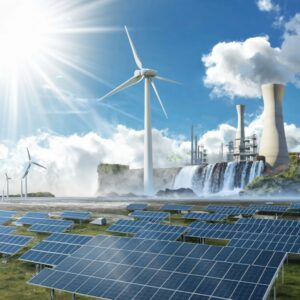
Welcome to my article on solar cell information, where I will provide you with a comprehensive understanding of how solar cells work and the environmental benefits they offer. Solar cells, also known as photovoltaic cells, are incredible devices that directly convert sunlight into electricity, paving the way for a sustainable and clean energy future.
Solar cells are made from semiconductor materials, typically silicon, and utilize the photovoltaic effect to generate electrical current. When sunlight strikes the solar cell, electrons become excited, creating a flow of electricity through the material. These solar cells are commonly used in solar panels to produce renewable energy that can power various applications, from homes to electric vehicles.
The environmental benefits of solar cells are significant. By harnessing the power of the sun, solar cells reduce greenhouse gas emissions and decrease our reliance on fossil fuels, which contribute to climate change. Solar energy is clean and does not produce harmful pollutants, such as carbon dioxide or sulfur dioxide, making it a sustainable and environmentally friendly alternative to traditional energy sources.
Join me on this journey as we explore the fascinating world of solar cells and discover the potential they hold for creating a greener tomorrow. Together, we can make a tangible difference in our quest for renewable energy and a sustainable future.
Key Takeaways:
- Solar cells directly convert sunlight into electricity through the photovoltaic effect
- They are made from semiconductor materials, typically silicon
- Solar cells are commonly used in solar panels for renewable energy production
- They reduce greenhouse gas emissions and decrease reliance on fossil fuels
- Solar cells provide clean energy, without emitting harmful pollutants
How Solar Cells Work
Solar cells are fascinating devices that generate electricity through the photovoltaic effect. This process occurs when sunlight, in the form of photons, strikes the surface of semiconductor materials like silicon.
When the photons interact with the semiconductor material, they transfer energy to the electrons, causing them to become excited and break free from their atoms. These excited electrons can then move freely through the material, creating a flow of electric current.
The solar cells themselves are arranged in a solar panel, which is made up of multiple interconnected cells. This configuration allows for the efficient collection of sunlight and maximizes the electricity generated. The electricity produced by the solar panel can be immediately used to power homes, businesses, or other electrical devices, or it can be stored in batteries for later use.
Solar cells are a key component of renewable energy systems. By harnessing the power of sunlight, they provide a reliable and sustainable source of electricity. Solar energy offers a cleaner alternative to traditional energy sources, reducing our reliance on non-renewable fossil fuels and minimizing the environmental impact associated with their extraction and combustion.
By using solar cells to harness the power of the sun, we can contribute to a cleaner and more sustainable energy system. Solar energy offers numerous advantages, including reduced greenhouse gas emissions, decreased air and water pollution, and a more secure and decentralized energy infrastructure.

The photovoltaic effect powering solar cells allows us to tap into the abundant and renewable energy of the sun. With ongoing advancements in solar cell technology, we can continue to unlock the full potential of renewable resources and pave the way towards a brighter and greener future.
Environmental Benefits of Solar Cells
Solar cells offer several environmental benefits. By converting sunlight into electricity, solar cells help reduce the need for energy generated from fossil fuels, which are the primary source of greenhouse gas emissions. This can significantly contribute to mitigating climate change and reducing carbon footprints.
“Solar energy is a clean and sustainable alternative to traditional power sources. By harnessing the power of the sun, we can reduce greenhouse gas emissions and combat climate change.”
Solar cells also produce clean energy, meaning they do not create air or water pollution during operation. Unlike fossil fuel power plants, solar cells do not emit harmful pollutants such as carbon dioxide, sulfur dioxide, or nitrogen oxides.
“Solar cells provide a cleaner energy solution, reducing air and water pollution while ensuring a healthier environment for all.”
Additionally, solar energy does not require the extraction and transportation of finite resources, further reducing the environmental impact. By adopting solar cells, individuals and communities can make a positive impact on the environment and contribute to a more sustainable future.
“Choosing solar cells means embracing clean energy and taking a step towards a greener tomorrow, free from the harmful effects of fossil fuels.”

Comparison of Solar Energy and Fossil Fuels in Environmental Impact
| Environmental Impact | Solar Energy | Fossil Fuels |
|---|---|---|
| Greenhouse Gas Emissions | Low to none | High |
| Air Pollution | No emissions | Significant emissions of pollutants |
| Water Pollution | No emissions | Potential for water contamination during extraction and transportation processes |
| Resource Depletion | No extraction or depletion of finite resources | Extraction and depletion of fossil fuels |
The table above highlights the key environmental impacts of solar energy compared to fossil fuels. Solar energy significantly reduces greenhouse gas emissions, air and water pollution, and reliance on finite resources.
“Solar energy emerges as a clear winner when it comes to reducing environmental harm. Embracing this clean energy source is a vital step toward a more sustainable future.”
Conclusion
Solar cells play a crucial role in the transition to a sustainable and clean energy future. By harnessing the power of the sun, these cells generate electricity and provide a renewable energy source that reduces our reliance on fossil fuels. The environmental benefits of solar cells are significant, including the reduction of greenhouse gas emissions, minimizing air and water pollution, and the conservation of finite resources.
By embracing solar energy and utilizing solar cells, we can contribute to a more sustainable future for our planet. The potential for solar cell technology to create a cleaner and more energy-efficient world is immense. It is essential to spread awareness about the benefits of solar cells and their role in creating a sustainable future.
Let us harness the power of the sun, unlock the full potential of renewable resources, and work towards a brighter and greener tomorrow.
FAQ
What are solar cells?
Solar cells, also known as photovoltaic cells, are devices that convert sunlight directly into electricity. They are made from semiconductor materials, typically silicon, and utilize the photovoltaic effect to generate electrical current.
How do solar cells work?
Solar cells function based on the photovoltaic effect, which occurs when photons from sunlight strike the surface of a semiconductor material, such as silicon. This excites the electrons in the material, allowing them to move and generate an electric current. The solar cells are arranged in a solar panel, which consists of multiple interconnected cells.
What is the purpose of a solar panel?
The solar panel is made up of multiple interconnected solar cells and is used to generate electricity from sunlight. The electricity generated by the solar panel can be used to power homes, businesses, and other electrical devices, or it can be stored in batteries for later use.
What are the environmental benefits of solar cells?
Solar cells offer several environmental benefits. By converting sunlight into electricity, solar cells help reduce the need for energy generated from fossil fuels, which are the primary source of greenhouse gas emissions. Solar cells also produce clean energy, meaning they do not create air or water pollution during operation. Unlike fossil fuel power plants, solar cells do not emit harmful pollutants such as carbon dioxide, sulfur dioxide, or nitrogen oxides.








